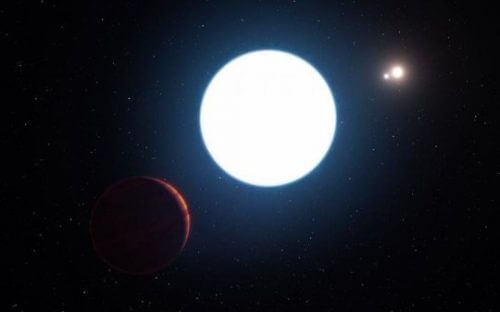A team of astronomers used the SPHERE instrument mounted on ESO's Very Large Telescope in Chile and recorded the first ever planet found in a wide orbit within a three-star system. The orbit of such a planet would be expected to be unstable, and as a result should have been quickly ejected from the system. But somehow this planet survived. This unexpected observation suggests that such systems may be more common than previously thought.

A team of astronomers used the SPHERE instrument mounted on ESO's Very Large Telescope in Chile and documented the first ever planet found in a wide orbit within a three-star system. The orbit of such a planet would be expected to be unstable, and as a result should have been quickly ejected from the system. But somehow this planet survived. This unexpected observation suggests that such systems may be more common than previously thought. The results were published in the online edition of the journal Science on July 7, 2016.
Luke Skywalker's home planet of Tatooine in the Star Wars saga was a strange world with two suns in the sky, but astronomers have now discovered a star in an even more exotic system, where an observer would either experience constant daylight or enjoy triple sunrises and sunsets every day, depending on the seasons.
This world was discovered by a team of astronomers led by researchers from the University of Arizona through direct imaging with ESO's Very Large Telescope (European Southern Observatory, VLT) in Chile. The planet, HD 131399Ab, is unlike any other known world - its orbit around the largest of the three stars is the widest known orbit in a multi-star system. Such orbits are often unstable, due to complex and varying gravitational forces from the other two stars in the system, and thus planets in stable orbits in a triple system were considered highly unlikely.
HD 131399Ab is located about 320 light-years from Earth in the direction of the constellation Centaurus (The Centaur), its age is about 16 million years, which also makes it one of the youngest planets discovered so far and one of the few that has been imaged directly. Its mass is estimated to be four Jupiter masses, it is also one of the coldest and least massive planets imaged directly.
"HD 131399Ab is one of the few planets that have been imaged directly, and it is the first to be in such interesting dynamics," said Daniel Appay of the University of Arizona, one of the authors of the paper.
"During about half of the planet's orbit, which lasts 550 Earth years, three stars are visible in the sky: two pale ones appear close to each other, and can be distinguished from the bright star throughout the year," adds Kevin Wagner, lead author of the article. Wagner, a doctoral student at the University of Arizona, identified the star out of hundreds of potential planets and led follow-up observations to determine its nature.
This is also the first discovery of a planet made using the SPHERE instrument on the VLT. The instrument is sensitive to infrared light, which allows it to detect the heat signatures of young planets, and in addition, it has sophisticated features to correct for atmospheric disturbances that block the host star's light.
Despite the extensive observations made of this planet, it will be necessary to determine the orbit of the planet among its host stars, observations and simulations suggest the following scenario: the bright star whose mass is estimated to be 80% higher than that of the Sun, and which has been nicknamed HD 131399A, surrounded itself by a pair of less massive stars, B and C, at a distance of about 300 astronomical units (an astronomical unit is defined as the average distance between the Earth and the Sun). All the while, B and C circle each other like a spinning dumbbell, separated by a distance equal to that between the Sun and Saturn (10 astronomical units).
In this scenario, the star HD 131399Ab moves in an orbit with a radius of about 80 AU around the large star, about twice the average distance of Pluto, bringing the planet to within a third of the distance between the massive star and the pair of smaller stars. The researchers note that a variety of orbital scenarios are possible in this situation and that the determination regarding the system's long-term stability will have to wait for planned follow-up observations.
"If the planet was further away from the most massive star in the system, it would have been kicked out of the system," Appay explained. "Our computer simulations showed that its trajectory can be stable, but it can also quickly go out of equilibrium."
Planets in multi-star systems are of particular interest to astronomers and planetary scientists because they provide an example of the nature of the star formation mechanism in these extreme scenarios. While multi-star systems seem exotic to us as we orbit our single star, multi-star systems are actually as common as single suns.
"It's not clear how this planet will ultimately survive its wide orbit in this extreme system and we can't say yet what that means for our broader understanding of the possible types of solar systems, but it shows that there is much more than we thought possible," Wagner concludes. "What we do know is that planets in multi-star systems have been much less studied, but they have potential due to their high number."

4 תגובות
It's annoying to read a Google translation for dance articles. The host star, the massive star, but it shows that there is much more than we thought possible, etc. The Academy of the Hebrew Language would call it a "spirit"
The movement of the suns in the system is more interesting than the movement of the planet
More interesting than the movement of the planet
Let them check if there is Trisolan there